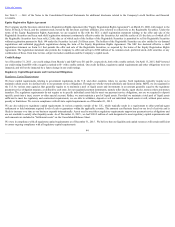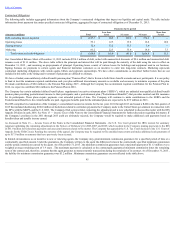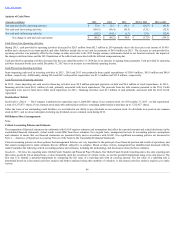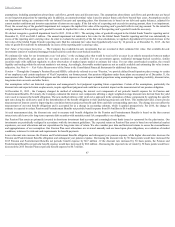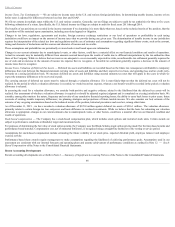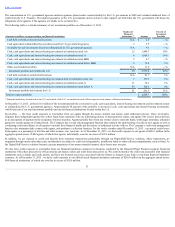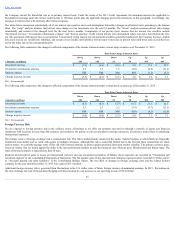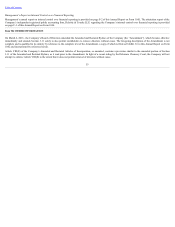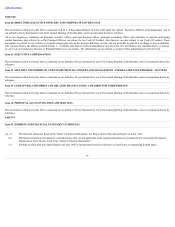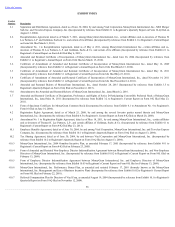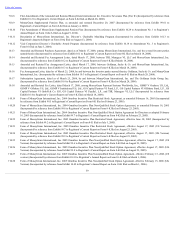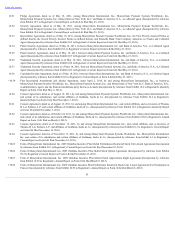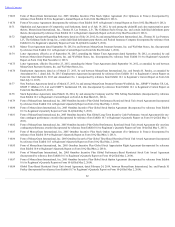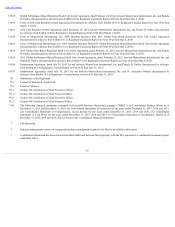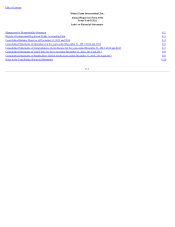MoneyGram 2015 Annual Report Download - page 55
Download and view the complete annual report
Please find page 55 of the 2015 MoneyGram annual report below. You can navigate through the pages in the report by either clicking on the pages listed below, or by using the keyword search tool below to find specific information within the annual report.
Table of Contents
In 2015, the euro was our second largest currency position in the world following the U.S. dollar. Had the euro appreciated or depreciated relative to the U.S. dollar
by 20 percent from actual exchange rates for 2015 , operating income would have increased/decreased approximately $9.5 million for the year. There are inherent
limitations in this sensitivity analysis, primarily due to the assumption that foreign exchange rate movements are linear and instantaneous, that the unhedged
exposure is static and that we would not hedge any additional exposure. As a result, the analysis is unable to reflect the potential effects of more complex market
changes that could arise, which may positively or negatively affect income.
Translation risk is generated from the accounting translation of the financial statements of foreign subsidiaries (from their functional currency) into U.S. dollars for
consolidation and does not have a significant impact on company results. These translation adjustments are recorded in "Accumulated other comprehensive loss"
on the Consolidated Balance Sheets.
Item 8. FINANCIAL STATEMENTS AND SUPPLEMENTARY DATA
The information called for by Item 8 is found in a separate section of this Annual Report on Form 10-K starting on pages F-1. See the “Index to Financial
Statements” on page F-1.
Item 9. CHANGES IN AND DISAGREEMENTS WITH ACCOUNTANTS ON ACCOUNTING AND FINANCIAL DISCLOSURE
None.
Item 9A. CONTROLS AND PROCEDURES
EvaluationofDisclosureControlsandProcedures
Disclosure controls and procedures are designed to ensure that information required to be disclosed in the Company’s reports filed or submitted under the
Securities Exchange Act of 1934, as amended (the "Exchange Act") is recorded, processed, summarized and reported within the time periods specified in the
SEC’s rules and forms. Disclosure controls and procedures are designed, without limitation, to ensure that information required to be disclosed in company reports
filed or submitted under the Exchange Act is accumulated and communicated to management, including the Company’s Chief Executive Officer and Chief
Financial Officer, to allow timely decisions regarding required disclosure.
As of the end of the period covered by this report, the Company’s management carried out an evaluation, under the supervision and with the participation of the
Chief Executive Officer and the Chief Financial Officer, of the effectiveness of the design and operation of the Company’s disclosure controls and procedures (as
defined in Rule 13a-15(e) of the Exchange Act). Based upon that evaluation, the Chief Executive Officer and Chief Financial Officer concluded that, as of
December 31, 2015 , the Company’s disclosure controls and procedures were effective.
ChangesinInternalControlOverFinancialReporting
As required by Rule 13a-15(d), the Company’s management, with the participation of the Chief Executive Officer and the Chief Financial Officer, also conducted
an evaluation of the Company’s internal control over financial reporting to determine whether any changes occurred during the quarter ended December 31, 2015
that have materially affected, or are reasonably likely to materially affect, the Company’s internal control over financial reporting. During the quarter ended
December 31, 2015 , the Company implemented a change in internal control over financial reporting. This change remediated a material weakness related to the
operating effectiveness of a control that is designed to identify new balance sheet accounts within the Company’s reconciliation software tool, ensuring that a
reconciler and reviewer are appropriately assigned. The material weakness began in August 2015 and was both identified and remediated in December 2015. The
Company has reconciled all accounts as of December 31, 2015 . The deficiency in the Company’s internal control over financial reporting did not result in any
material misstatements in the Company’s consolidated financial statements. The testing of the additional control process outlined above has been completed and
the Company’s management has concluded that the material weakness was remediated as of December 31, 2015 . Other than as described above, there were no
changes in the Company’s internal control over financial reporting (as defined in Rule 13a-15(f) of the Exchange Act) during the fiscal quarter ended
December 31, 2015 that have materially affected, or are reasonably likely to materially affect, the Company’s internal control over financial reporting.
54


